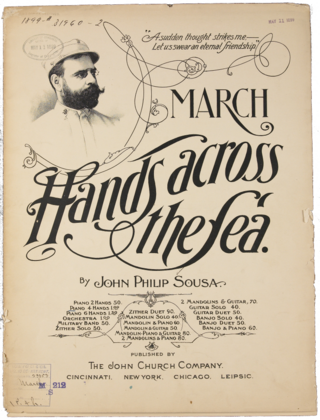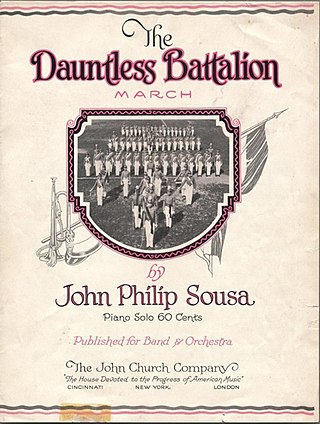
John Philip Sousa was an American composer and conductor of the late Romantic era known primarily for American military marches. He is known as "The March King" or the "American March King", to distinguish him from his British counterpart Kenneth J. Alford. Among Sousa's best-known marches are "The Stars and Stripes Forever", "Semper Fidelis", "The Liberty Bell", "The Thunderer", and "The Washington Post".

American march music is march music written and/or performed in the United States. Its origins are those of European composers borrowing from the military music of the Ottoman Empire in place there from the 16th century. The American genre developed after the British model during the colonial and Revolutionary periods, then later as military ceremonials and for civilian entertainment events.

"Hands Across the Sea" is an American military march composed by John Philip Sousa in 1899.

"The Stars and Stripes Forever" is a patriotic American march written and composed by John Philip Sousa in 1896. By a 1987 act of the U.S. Congress, it is the official National March of the United States of America.

"The Fairest of the Fair" is a 1908 march by John Philip Sousa. One of Sousa's more melodic, less military marches, it was composed for the annual Boston Food Fair of 1908. It is claimed that the memory of a pretty girl he had seen at an earlier fair inspired the composition.
Minnesota March is a march for wind band written by John Philip Sousa in 1927 for the University of Minnesota at the request of the Minnesota football team. Sousa used Indian themes in this march, and later added field drum and bugle parts. The piece was one of four marches written by Sousa expressly for a university. It is now used as one of the university's school songs, with lyrics written in 1927 by university band director Michael Jalma. The piece is regularly performed by the University of Minnesota Marching Band and pep bands and often sung by students at various athletic events and ceremonies.
Gilbert Vinter was an English conductor and composer, most celebrated for his compositions for brass bands.

Heritage of the March is a series of 185 vinyl records of marches and galops released from 1973 to 1988. It remains the largest single march music record series in history, featuring close to 3,000 different marches.
Jan van Beekum was a Dutch Composer and Conductor.

"Semper Fidelis", written in 1888 by John Philip Sousa, is regarded as the official march of the United States Marine Corps. This piece was one of two composed in response to a request from United States President Chester A. Arthur for a new piece to be associated with the United States President. The words semper fidelis are Latin for "always faithful." The piece was created for a wind band in addition to a percussion section. There is a very prominent drum solo in the middle of the piece which includes a skillful dynamic change. It features staccato notes and sharp tonguing.

Bohumir Kryl was a Czech-American financial executive and art collector who is most famous as a cornetist, bandleader, and pioneer recording artist, for both his solo work and as a leader of popular and Bohemian bands. He was one of the major creative figures in the era of American music known as the "Golden Age of the Bands".
William Lockwood Huff was a composer of band music best known for his military marches and the circus march The Squealer. He was born in Massieville, Ohio and grew up in Coalton, Ohio. He took up his father's profession as a photographer and later became an interior decorator. He briefly performed in a circus band and in the National Guard, playing cornet and alto horn. His earliest works were published during the Spanish–American War with a later spurt of activity around World War I. After the later war, he settled down in Chillicothe, Ohio where he led an Odd Fellows band until his death in 1942.
Frank Bencriscutto, nicknamed "Dr. Ben," was an American conductor and composer of concert band music. Bencriscutto was Director of Bands and Professor of Music at the University of Minnesota for thirty-two years.
Paul Edmund Bierley was an American music historian. Among his awards were a Society for American Music Lifetime Achievement Award and receiving an Honorary Doctor of Music from Ohio State University.

"Nobles of the Mystic Shrine" is a march composed by John Philip Sousa upon the request of his nephew, A. R. Varela. Sousa dedicated the march to the Almas Temple and the Ancient Arabic Order of the Nobles of the Mystic Shrine. It was first conducted in June 1923, with a band of around 6,200 members—the largest Sousa had ever conducted. It is one of the few Sousa marches with the first strain written in the minor mode. Contemporary versions of the march recorded by the Ottoman military band also use the Jingling Johnny in the final strain.

Boy Scouts of America is a march composed by John Philip Sousa in 1916 upon the request of Charles D. Hart. Sousa dedicated it to the Boy Scouts of America. It was premiered in October 1916 at the Metropolitan Opera House. The cover sheet features a photograph of a statuette R. Tait McKenzie's The Ideal Scout. It is considered one of the best marches Sousa ever composed, with The Reading Times writing that the march proved that the "noted composer still retains the name of 'March King'".

"The Dauntless Battalion" is an American military march by John Philip Sousa, published in 1922 and dedicated to the faculty and cadets of the Pennsylvania Military College in Chester, Pennsylvania, known today as Widener University. Sousa received an honorary doctorate from the college in February 1920 alongside future president Warren G. Harding.

Stephen Bulla is an American composer and musician best known compositions for the United States Marine Band and The Salvation Army.












